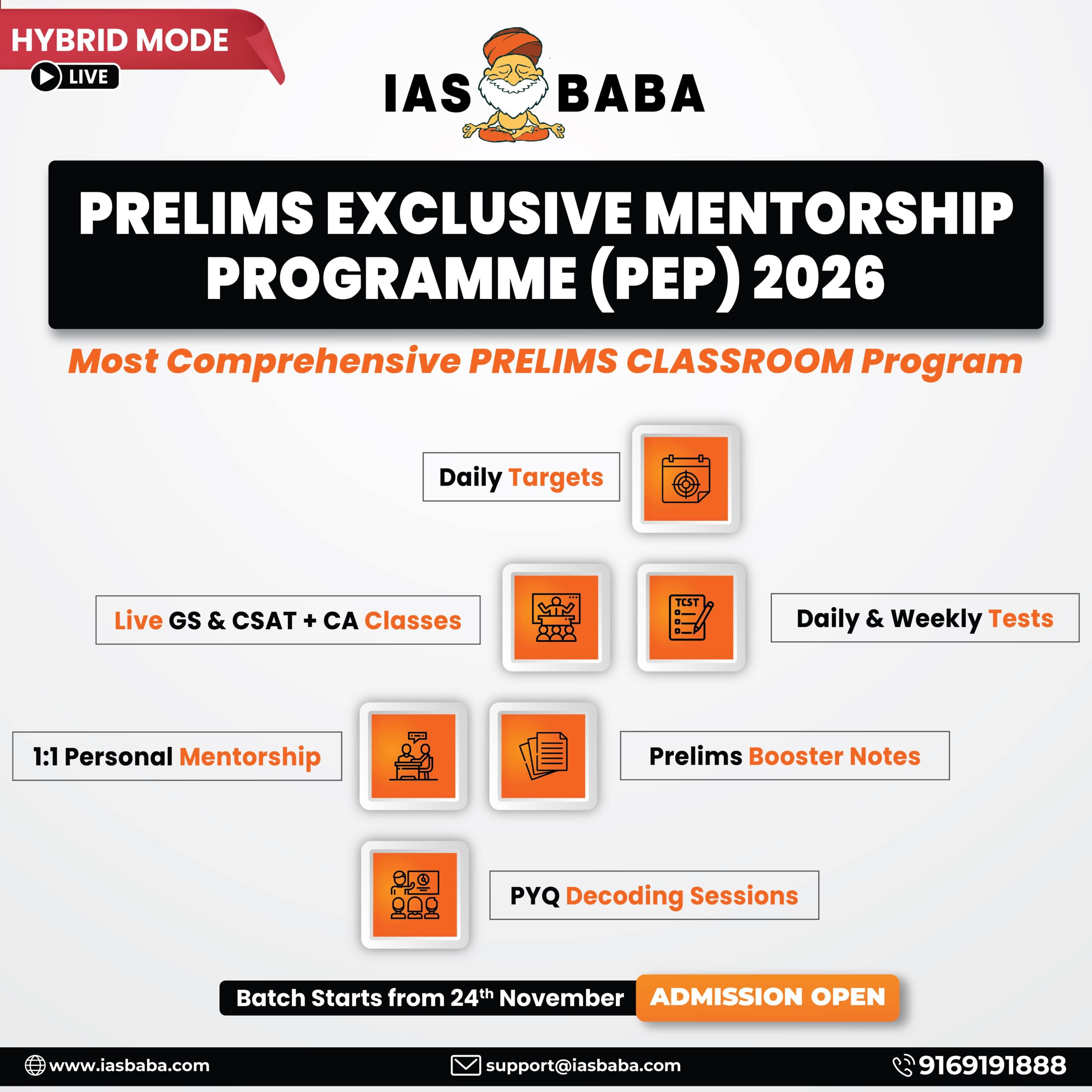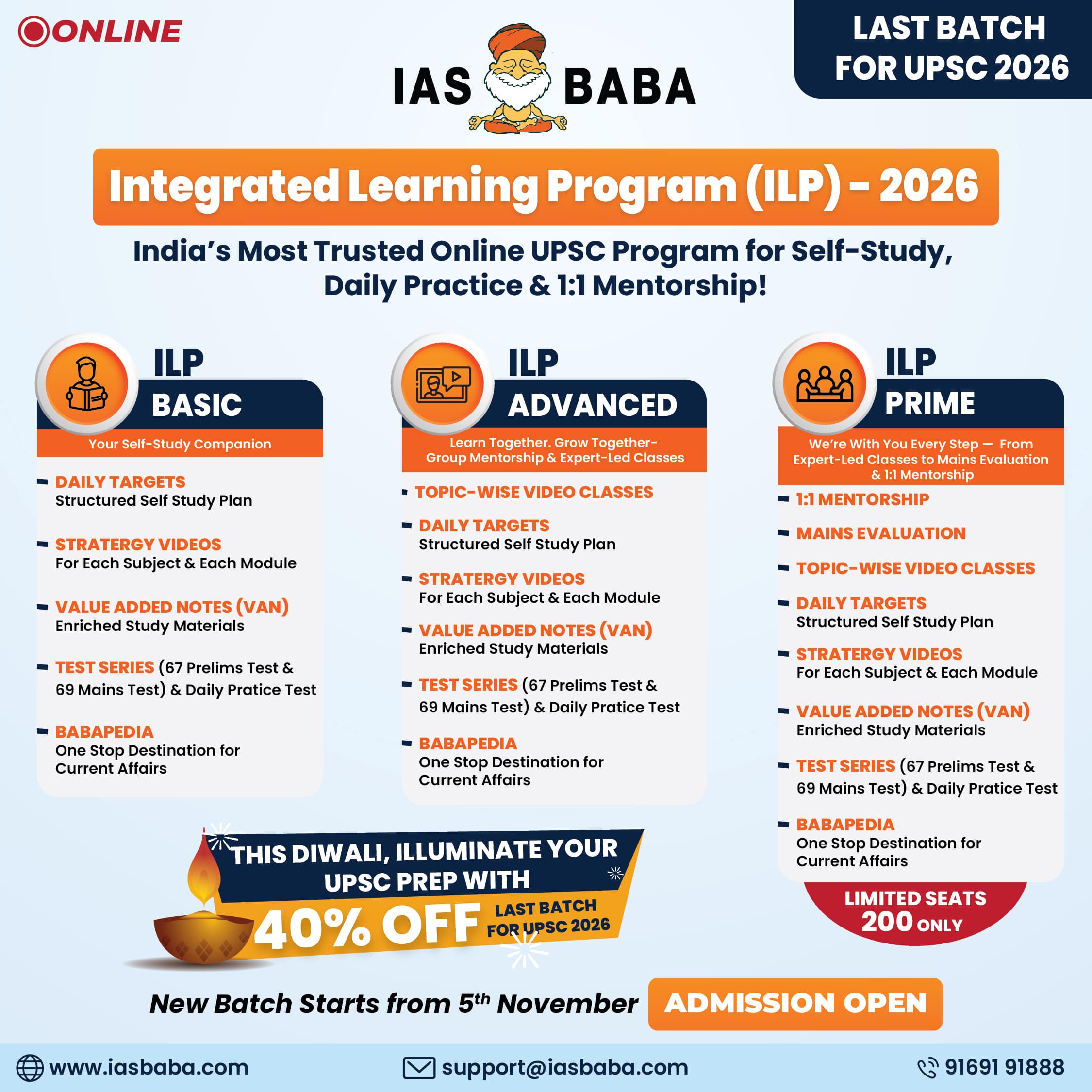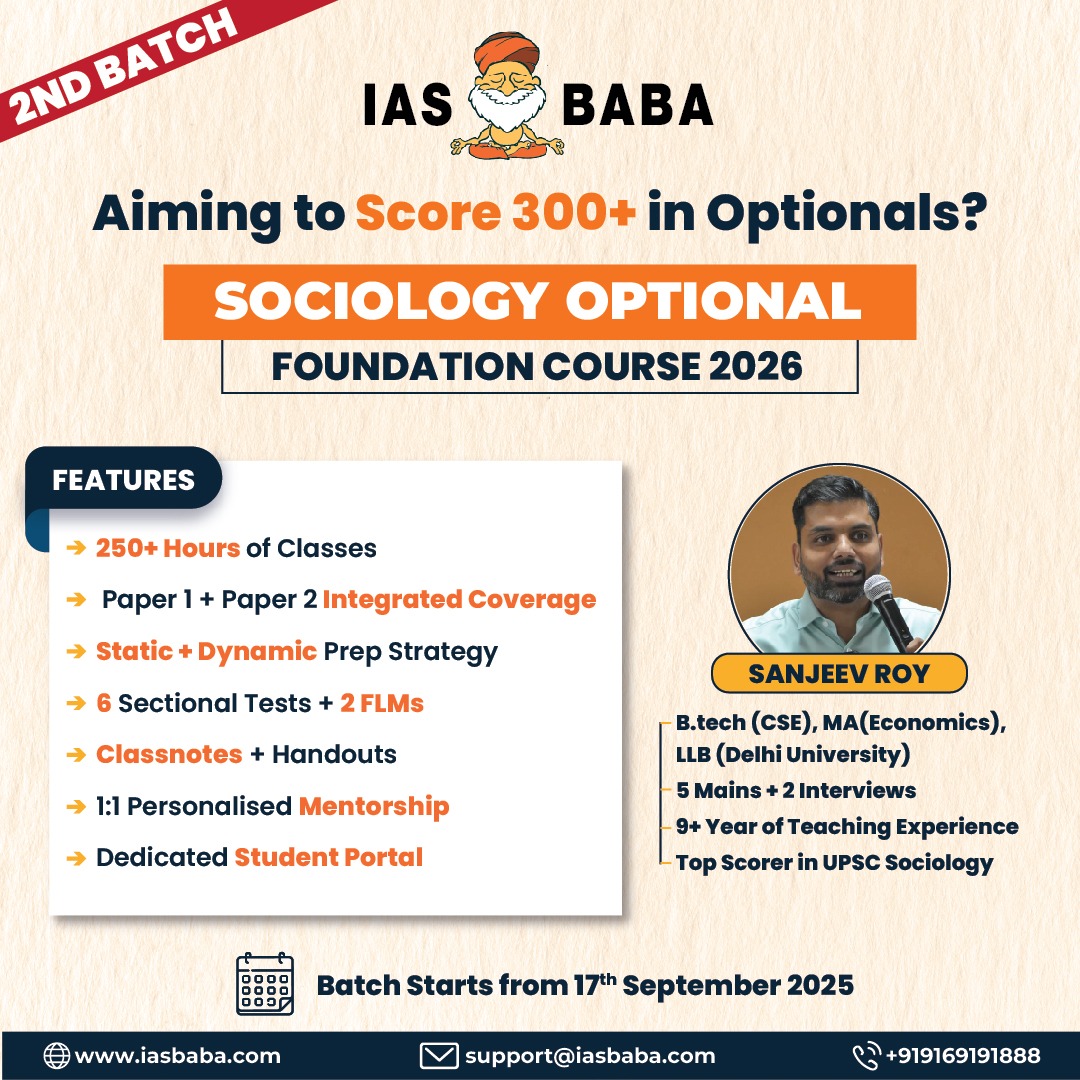IASbaba's Daily Current Affairs Analysis
rchives
(PRELIMS Focus)
Category: HISTORY
Context: 100 Years of the Self-Respect Movement in Tamil Nadu
Origins and Description
- Began in 1925 as a movement against caste and gender hierarchy.
- Led by Periyar E.V. Ramasamy, who used the Tamil weekly Kudi Arasu to spread radical, non-Brahmin ideas.
Political Impact
- Periyar engaged with the Justice Party, advocating militant non-Brahminism to counter Congress’s caste politics.
- Offered an alternative social reform agenda, challenging upper-caste dominance.
Radical Social Reforms
- Popularized self-respect marriages, promoted women’s rights (remarriage, property), and expanded public debate.
- Kudi Arasu articulated radical positions on caste and gender, influencing reforms in Hindu society.
Justice Party’s Role
- The South Indian Liberal Federation empowered non-Brahmins and widened political participation.
- However, non-elite non-Brahmins often remained marginalized.
Legacy and Recognition
- Fostered awareness and pride among non-Brahmin masses about their rights.
- Its legacy reshaped caste dynamics, gender politics, and social reform, retaining relevance in contemporary Tamil society.
Learning Corner:
E.V. Ramasamy (Periyar)
- Born: 17 September 1879, Erode, Tamil Nadu
- Known as: Periyar (“The Great One”)
Role in Social Reform
- Founded the Self-Respect Movement (1925) to challenge caste hierarchy, Brahminical dominance, and gender inequality.
- Advocated rationalism, atheism, and social justice, rejecting religious orthodoxy and superstition.
- Strongly opposed untouchability, hereditary caste privileges, and dominance of upper castes in politics and society.
Political Engagement
- Initially associated with the Indian National Congress, but resigned due to differences over caste discrimination.
- Later allied with the Justice Party, pushing for non-Brahmin representation in politics and education.
- Played a major role in shaping Dravidian ideology, which later influenced parties like DMK and AIADMK.
Key Reforms
- Promoted Self-Respect Marriages (without Brahmin priests, based on equality).
- Championed women’s rights: widow remarriage, right to property, education, and opposition to child marriage.
- Used journalism (Kudi Arasu weekly) and public debates to spread rationalist and egalitarian ideas.
Legacy
- Revered as the “Father of the Dravidian Movement.”
- Left a lasting impact on Tamil society, politics, and social justice discourse.
- His ideas continue to shape debates on caste, rationalism, and social reform in South India.
Source: THE HINDU
Category: INTERNATIONAL
Context : India at SCO Trade Ministers’ Meeting, Vladivostok
Key Highlights
- Reaffirmed commitment to a WTO-centered, open, fair, and inclusive multilateral trading system.
- Called for a development-centered trade agenda, including:
- Permanent solution on public stockholding for food security.
- Effective Special and Differential Treatment for developing nations.
- Urged restoration of a two-tier WTO dispute settlement system.
- Emphasized need for transparent export measures, warning against misuse and artificial scarcity.
- Stressed export diversification, resilient supply chains, and MSME integration for shared prosperity.
Broader Priorities
- Showcased India’s Digital Public Infrastructure (UPI, ONDC) and proposed SCO collaboration on digital economy and secure digitalization.
- Advocated climate action on the principle of Common but Differentiated Responsibilities, opposing trade-linked discrimination.
- Highlighted AVGC sector (Animation, Visual Effects, Gaming & Comics) as a driver of jobs, exports, and creative industries.
Significance
- Strengthens rule-based, fair, and inclusive trade through WTO.
- Enhances regional economic cooperation, connectivity, and sustainable growth within SCO.
Learning Corner:
World Trade Organization (WTO)
- Established: 1 January 1995 (replacing GATT, 1947).
- Headquarters: Geneva, Switzerland.
- Membership: 164 members (including India).
Objectives
- Promote free, fair, and predictable international trade.
- Provide a platform for trade negotiations and settlement of disputes.
- Ensure non-discrimination through Most Favoured Nation (MFN) and National Treatment principles.
- Support developing countries through Special and Differential Treatment (S&DT).
Core Functions
- Administers WTO Agreements (on goods, services, and intellectual property – TRIPS, GATS, AoA).
- Trade Dispute Settlement: Operates a two-tier system – Panel and Appellate Body.
- Monitoring and Transparency: Oversees trade policies of members through reviews.
- Capacity Building: Technical assistance and training for developing/least developed countries.
Current Issues
- Appellate Body Crisis: Non-functioning since 2019 due to U.S. opposition to judge appointments.
- Agriculture Negotiations: Dispute over food security, subsidies, and public stockholding.
- Digital Trade: Rules on e-commerce and data flow are contested.
- Developing Country Concerns: Need for fairer S&DT provisions.
Significance
- Provides a rule-based multilateral trading system, preventing unilateralism.
- Ensures predictability, transparency, and stability in global trade.
- Key platform for addressing global challenges like supply chain resilience, climate-linked trade issues, and digital economy.
Source: PIB
Category: HISTORY
Context: Marks the birth centenary of Bharat Ratna Dr. Bhupen Hazarika, the “Bard of the Brahmaputra.”
- Named after his iconic song Bistirna Parore, symbolizing unity and cultural resilience.
- Began at Guijan, Dibrugarh, featuring live renditions of Hazarika’s songs, folk performances, and cultural showcases by communities like Moran, Motok, Tea Tribe, Sonowal Kachari, Deuri, and Gorkha.
Dr. Bhupen Hazarika’s Musical Legacy
- Bistirna Parore, inspired by Ol’ Man River, turned the Brahmaputra into a metaphor for human struggle, justice, and solidarity.
- His music united generations, carried Assam’s culture to global audiences, and embodied peace and brotherhood.
Significance
- Serves as a living tribute to Hazarika’s unmatched influence.
- Celebrates Assam’s cultural diversity, creativity, and collective spirit along the Brahmaputra.
Learning Corner:
Dr. Bhupen Hazarika
- Born: 8 September 1926, Sadiya, Assam
- Known as: Bard of the Brahmaputra
- Profession: Singer, lyricist, composer, poet, filmmaker, and cultural icon.
Contributions
- Gave voice to the struggles, hopes, and unity of people through songs rooted in Assamese folk traditions.
- His iconic song Bistirna Parore used the Brahmaputra as a metaphor for justice, solidarity, and resilience (inspired by Ol’ Man River).
- Brought Assamese and North-Eastern culture to national and global platforms.
- Advocated themes of peace, universal brotherhood, and social justice through music and films.
- Composed music for Assamese, Bengali, and Hindi films, making regional music nationally popular.
Recognitions
- Bharat Ratna (2019) – India’s highest civilian award.
- Padma Vibhushan (2012, posthumous), Padma Bhushan (2001).
- Recipient of Dadasaheb Phalke Award (1992) for contribution to Indian cinema.
Legacy
- Revered as a cultural unifier of Assam and the North-East.
- Left behind a legacy of socially conscious art that continues to inspire movements for justice, equality, and cultural pride.
- His centenary is celebrated with music and cultural programs across Assam and beyond.
Source: PIB
Category: HISTORY
Context : Tribute to Sree Narayana Guru on His Birth Anniversary
- The Prime Minister paid tribute to Sree Narayana Guru, recalling his vision of equality, compassion, and universal brotherhood.
- Guru’s teachings on social reform and education were praised as guiding principles for building a progressive and inclusive society.
- A revered reformer and spiritual leader from Kerala, he fought against caste discrimination and promoted justice, empowerment, and moral strength.
- His legacy continues to inspire unity, ethical values, and social equality in contemporary India.
Learning Corner:
Sree Narayana Guru (1855–1928)
Early Life
- Born in 1855 at Chempazhanthi, near Thiruvananthapuram, Kerala, in the Ezhava community.
- A philosopher, saint, and social reformer who challenged rigid caste hierarchies in Kerala.
Key Teachings & Philosophy
- Advocated “One Caste, One Religion, One God for Man” (Ekam sat vipra bahudha vadanti).
- Stressed on education, spiritual upliftment, and social equality as the path to empowerment.
- Rejected caste-based discrimination and ritualistic practices.
Social Reforms
- Consecrated a Shiva idol at Aruvippuram (1888), breaking caste monopoly in temple entry and priesthood.
- Founded SNDP Yogam (Sree Narayana Dharma Paripalana Yogam) in 1903 with Dr. Palpu and Kumaran Asan, to uplift backward classes through education and social reform.
- Promoted inter-caste dining and marriages, and encouraged use of rational, ethical practices in worship.
Legacy
- Inspired later leaders like Mahatma Gandhi, who visited him in 1925 and praised his reformist vision.
- Played a central role in shaping Kerala’s renaissance and social justice movement.
- Remembered as a symbol of equality, compassion, universal brotherhood, and education-driven empowerment.
Source: PIB
Category: ECONOMICS
Context: India’s Foreign Capital Inflows at a Low.
- Despite being the world’s fastest-growing major economy with GDP growth averaging over 8% (2021–2024), India is witnessing capital inflows at a 15-year low.
- Foreign Portfolio Investment has remained weak, with only 2021–22 showing notable inflows. Recent quarters of strong GDP growth also failed to attract significant capital.
Balance of Payments
- Trade deficits continue, but services exports and remittances have supported the current account.
- However, these invisibles have not translated into higher capital investment inflows.
Reasons for Low Inflows
- Strong outflows due to FPI withdrawals and exits by private equity/venture funds.
- High stock valuations, global risk aversion, and tighter cross-border financing rules further limit inflows.
Implications
- Persistent low foreign capital may constrain financing options for future growth.
- India must address investment climate and policy measures to ensure adequate capital for expansion.
Learning Corner:
External Trade and Balance of Payments (BoP) – Detailed Note
Definition of External Trade
External trade refers to the exchange of goods, services, and capital between residents of a country and the rest of the world. It plays a critical role in a country’s economic growth, foreign exchange earnings, and integration with the global economy.
Components of External Trade
Exports
- Goods or services sold by domestic entities to foreign countries.
- Types:
- Merchandise Exports: Physical goods like textiles, electronics, agricultural produce.
- Service Exports: IT services, tourism, consultancy, transport.
Imports
- Goods or services purchased from foreign countries.
- Types:
- Merchandise Imports: Crude oil, machinery, electronics.
- Service Imports: Consultancy, tourism, software outsourcing.
Visible and Invisible Trade
- Visible Trade: Trade in physical goods only; measured through merchandise exports and imports.
- Invisible Trade: Trade in services, income, and transfers. Includes:
- Services: IT, banking, insurance, transport, tourism.
- Income: Interest, dividends, profits received from foreign investments.
- Transfers: Remittances from NRIs, foreign aid, grants, donations.
Balance of Payments (BoP)
BoP is a systematic record of all economic transactions between residents of a country and the rest of the world over a specific period. It ensures that the country’s international transactions are properly accounted.
BoP Components:
Current Account
- Records all transactions related to goods, services, income, and transfers.
- Sub-components:
- Balance of Trade (BoT): Difference between merchandise exports and imports.
- BoT Surplus: Exports > Imports.
- BoT Deficit: Imports > Exports.
- Net Services: Trade in services (IT, tourism, transport, royalties).
- Net Income: Income from investments abroad (interest, dividends, profits).
- Net Transfers: Remittances, foreign aid, grants.
- Balance of Trade (BoT): Difference between merchandise exports and imports.
Importance:
- Reflects the short-term external economic position of a country.
- Current account deficit indicates higher dependence on foreign capital.
Capital Account (Financial Account)
- Records cross-border financial transactions that change the ownership of national assets.
- Components:
- Foreign Direct Investment (FDI): Investment in business/industry abroad or by foreigners in domestic businesses.
- Portfolio Investment (FPI): Investment in stocks, bonds, and securities.
- External Commercial Borrowings (ECB): Loans raised by domestic entities from abroad.
- Banking Capital & NRI Deposits: Movement of funds by banks and Non-Resident Indians.
- Other Investments: Trade credits, loans, currency deposits.
Importance:
- Supports financing of current account deficits.
- Influences foreign exchange reserves and currency stability.
BoP Identity and Accounting
- In accounting terms, BoP always balances:
- Any deficit in current account is offset by surplus in capital account or changes in foreign exchange reserves.
- Persistent imbalance may affect currency stability and require policy intervention.
Importance of External Trade and BoP
- Economic Growth: Exports boost GDP and foreign exchange.
- Foreign Exchange Reserves: Maintain currency stability and meet import requirements.
- Investment Climate: Capital inflows attract technology, skills, and finance.
- Policy Formulation: Helps the government plan trade, investment, and monetary policies.
- Global Integration: Promotes participation in international markets.
Source: THE INDIAN EXPRESS
(MAINS Focus)
Introduction (Context)
Indian cities are at the forefront of the country’s economic and demographic transformation. By 2030, they will generate 70% of new jobs, and by 2050, India’s urban population will approach one billion.
The new infrastructure will need to withstand the growing impacts of climate change.
It will therefore be essential to make early investments in climate-resilient urban design and infrastructure to avert billions of dollars in annual damages while saving countless lives.
Key Risks for Indian Cities and solutions
Floods
- Floods are emerging as a major risk for Indian cities.
- With rapid housing and infrastructure construction, over two-thirds of urban residents will face pluvial or surface flooding.
- Projected economic losses: $5 billion by 2030 and $30 billion by 2070.
- An integrated approach is needed to address this risk, including:
- Demarcating high-risk areas as no-build zones.
- Expanding and upgrading city-wide drainage systems.
- Promoting nature-based solutions to absorb excess rainwater.
- Establishing flood forecasting and warning systems.
- Examples:
- Brazil, now 80% urban, has shifted from structural flood control to integrated, nature-based approaches.
- Kolkata Implemented a city-level flood forecasting and warning system.
- Chennai is Enhancing stormwater management and flood preparedness, focusing on vulnerable populations.
Extreme Heat
- The urban heat island effect is raising nighttime city temperatures by 3°C to 5°C above surrounding areas year-round.
- Temperatures are expected to rise further throughout the 21st century.
- Cities can build on Ahmedabad’s Heat Action Plan as a model.
- Key measures include:
- Increasing tree cover and green canopies.
- Replacing heat-trapping roofs with cool roofs.
- Adjusting working hours for outdoor labourers.
- Scaling up these actions across major cities can:
- Avert hundreds of thousands of deaths annually.
- Safeguard economic productivity during peak summer months.
Poor transport infrastructure
- Efficiency of transportation is vital for urban productivity.
- Over a quarter of India’s urban roads are exposed to flooding.
- In some cities, inundation of just 10–20% of roads can disrupt more than half of transport systems.
- Flood-risk mapping, improved drainage, alternative routes, and investment in flood protection and road maintenance are essential to prevent disruptions.
- Large investments in modernising municipal services such as waste collection and waste-to-energy conversion are needed.
How to build Climate-Resilient Cities?
- Build technical and administrative capacity for climate-risk assessment and enforcement of urban planning norms.
- Equip ULBs with modern tools like GIS mapping, early warning systems, and climate modelling. Ensure adequate staffing, funding, and training for city-level institutions.
- Climate resilience requires integrated planning across housing, water supply, transport, and environment departments. Establish joint task forces and data-sharing mechanisms among agencies to prevent fragmented responses.
- Encourage convergence of schemes such as AMRUT, Smart Cities Mission, and Jal Jeevan Mission with climate adaptation goals.
- Local communities should be partners in designing and maintaining green infrastructure such as parks, urban forests, and wetlands.
- Launch targeted campaigns on heat action, flood safety, and sustainable lifestyles.
- School and university curricula can integrate climate adaptation awareness.
- Ensure incentives for green building designs, energy-efficient housing, and renewable energy integration.
- Prioritise resilient infrastructure funding through urban climate adaptation funds and disaster mitigation budgets.
- Ensure corporate participation in sustainable mobility, clean energy, and waste-to-energy initiatives.
Conclusion
Around $10.95 trillion is needed y 2050 for climate-resilient, low-carbon cities. This investment can prevent billions in climate-related damages annually. Returns include creation of new green jobs, enhanced innovation ecosystems, improved health outcomes, and global competitiveness.
Hence Early investments today will reduce disaster losses, save lives, and make Indian cities inclusive and globally attractive for investment.
Mains Practice Question
Q Discuss the key challenges in building climate-resilient cities in India and suggest measures to address them. (250 words, 15 marks)
Source: What India should do to build climate-resilient cities | The Indian Express
Introduction (Context)
Foreign Direct Investment (FDI) has been a critical driver of India’s growth since the 1991 economic reforms. It modernised industries, introduced new technologies, and integrated India with global markets.
However, recent trends reveal a troubling pattern: while India continues to attract FDI, much of it is short-term in nature, with rising disinvestments and Indian firms increasingly investing abroad. This divergence raises systemic concerns about India’s investment climate.

Current trends in FDI sector
- Gross FDI inflows reached $81 billion in FY 2024-25, up 13.7% from the previous year.
- Post-COVID inflows grew at just 0.3% annually, while disinvestments rose 18.9% annually.
- Despite $308.5 billion gross inflows since COVID, $153.9 billion was repatriated. After adjusting for Indian outward FDI, the net retained capital fell to just $0.4 billion.
- Manufacturing share in total FDI dropped to 12%, reflecting a preference for short-term and non-productive sectors.
- Investors prefer financial services, energy distribution, and hospitality over long-term sectors like manufacturing or advanced technology.
- Indian firms investing abroad: Outflows grew from $13 billion in FY 2011–12 to $29.2 billion in FY 2024–25, citing regulatory inefficiency, policy unpredictability, and infrastructure gaps.
Thus, a large outflow limits FDI’s long term development impact. These figures indicate that the capital does not stay long enough, limiting its long-term developmental impact.
Why long term investment important?
FDI inflows are expected to help India by:
- Increasing fixed investment (factories, plants, offices).
- Expanding production capacity (making more goods and services).
- Bringing new technologies (e.g., robotics in manufacturing).
- Sharing global best practices (management, efficiency, quality control).
However, recent trend is that:
- The gross foreign inflow-to-GDP ratio steadily declined from 3.1% in 2020-21 to 2.1% in 2024-25 and net FDI fell from 1.6% of GDP to zero in the same period.
- India receives foreign money, but much of it exits quickly through repatriation (profits taken home) and disinvestment (withdrawal of capital).
- Outward FDI by Indian firms rose from $13 billion in FY 2011-12 to $29.2 billion in FY 2024-25.
- Companies cite regulatory inefficiencies, infrastructure gaps, and unpredictable policy frameworks as reasons for investing abroad.
- Outflow of capital weakens the domestic economy by limiting job creation, slowing innovation, and reducing industrial growth.
- Reduced inflows in R&D and high-value manufacturing slow India’s competitiveness.
- Despite government reforms and improved global rankings, regulatory opacity, legal unpredictability, and inconsistent governance continue to discourage investors.
- Both foreign firms withdrawing funds and Indian firms investing abroad reveal systemic weaknesses that must be addressed to stabilise India’s investment climate.
Way Forward
- India should prioritise long-term, strategic capital over short-term tax-driven flows.
- Simplified and transparent regulations are essential to build investor trust.
- Stable tax regimes, consistent policies, and legal clarity will sustain investor confidence.
- Infrastructure development in transport, energy, and digital connectivity must reduce business costs.
- FDI should be directed toward manufacturing, technology, AI, semiconductors, and clean energy rather than rent-seeking sectors.
- Heavy investment in education, vocational training, and R&D is needed for a skilled workforce.
- Industry–academia collaboration can foster innovation and attract knowledge-driven investment.
- Stronger monitoring is required to curb round-tripping and identify genuine productive inflows.
- Effective implementation of laws, contract enforcement, and anti-corruption measures will improve credibility.
- FDI must align with national priorities like green growth, Atmanirbhar Bharat, and digital transformation to ensure sustainable development.
Conclusion
India’s FDI story, once hailed as a success of liberalisation, now faces structural challenges. The growing gap between inflows and outflows, dominance of short-term investments, and rising Indian outward FDI reflect weakening domestic confidence. For sustainable growth, India must shift focus from headline FDI figures to quality, durability, and alignment of investments with its developmental priorities.
Mains Practice Question
Q India’s FDI story appears robust in gross figures but masks deeper vulnerabilities of short-termism, high disinvestments, and rising outward investment by Indian firms. Elaborate. (250 words, 15 marks)














